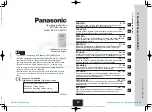
of 600 square feet (56 square meters). The
sensor must have a clear and unobstructed
view of the coverage area. Objects blocking
the sensor’s lens may prevent detection
thereby causing the light to turn OFF even
though someone is in the area.
Windows, glass doors, and
other transparent barriers
will obstruct the sensor’s view and prevent detection.
INSTALLATION & WIRING
These instructions describe only the 3-way circuit applications. For information
about other applications, consult technical support.
WARNING
Disconnect power to the wall switch box by turning OFF
the circuit breaker or removing the fuse for the circuit before
installing the CH-250, replacing lamps, or doing any electrical work.
1. Prepare the switch box.
After the power is turned OFF at the circuit breaker box, remove the existing
wall plate and mounting screws. Pull the old switch out from the wall box.
2. Identify the type of circuit.
You may connect the CH-250 to a single pole or multi-way circuit. If you are
unable to clearly identify some or all of the wires mentioned in this manual,
you should consult with a qualified electrician.
In a 3-way circuit (see Fig. 2), two traveler wires connect to both switches.
Another wire provides power from the circuit box to one of the switches. A wire
connects from one switch to the load. A ground wire may also be connected to
a ground terminal on the old switches. A neutral wire should also be present in
both wall boxes.
NEUTRAL
GROUND
LOAD/Common
(power to lamp)
NEUTRAL
GROUND
HOT/Common
(power from circuit box)
TRAVELER
TRAVELER
Lamp/load
MASTER SWITCH
AUXILIARY SWITCH
Fig. 2: Typical 3-Way Switch Wiring
www.wattstopper.com
25'
(7.6m)
12'
(3.7m)
Fig. 1: Sensor Coverage Area
























